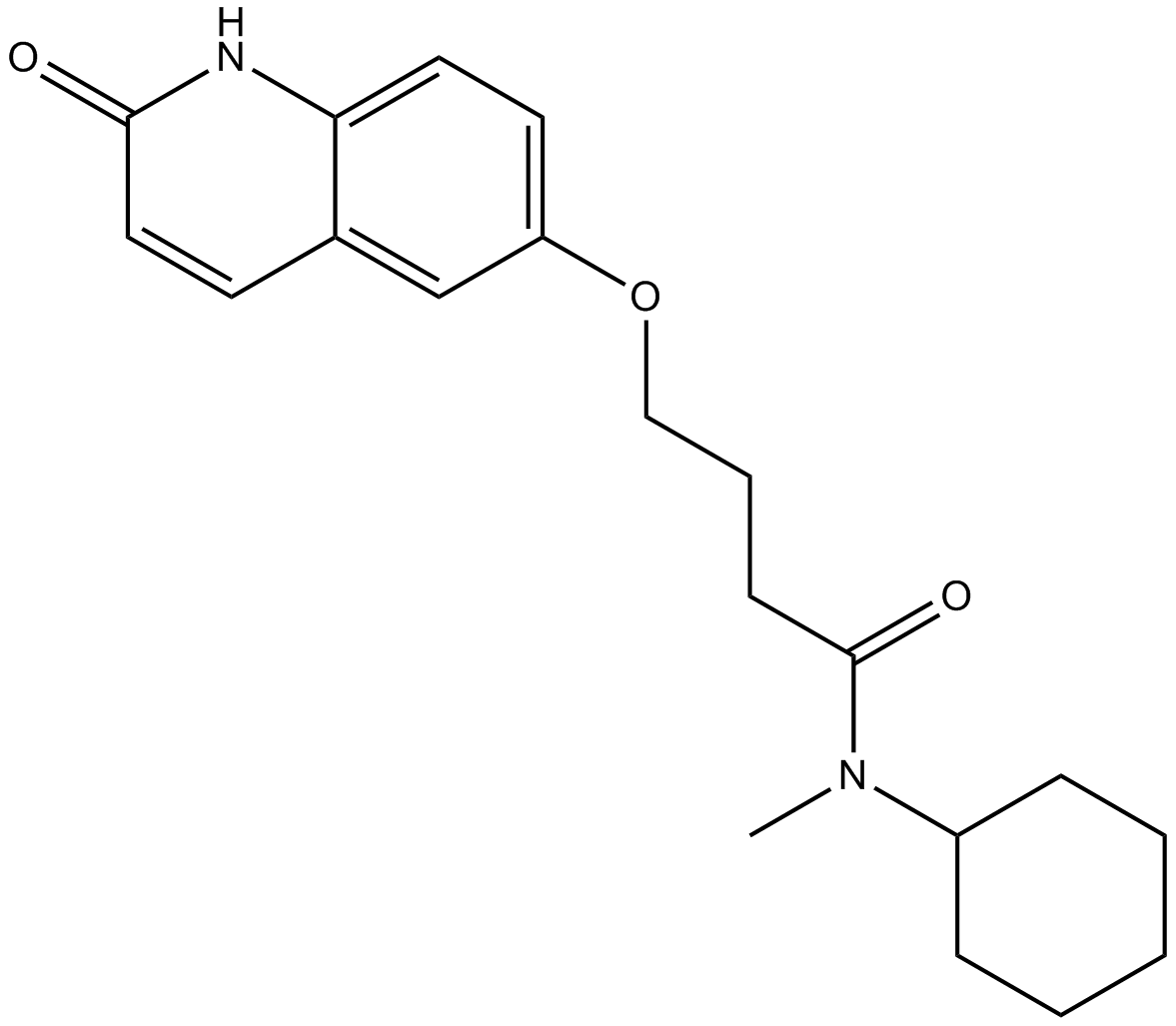Cilostamide (Synonyms: OPC 3689) |
| Catalog No.GC10109 |
type III phosphodiesterase (PDE3) inhibitor
Products are for research use only. Not for human use. We do not sell to patients.

Cas No.: 68550-75-4
Sample solution is provided at 25 µL, 10mM.
Cilostamide is a selective and potent PDE3 inhibitor, with IC50s of 27 nM and 50 nM for PDE3A and PDE3B, respectively, and has antithrombotic and anti-intimal hyperplastic activity.
Cilostamide is a selective and potent PDE3 inhibitor, with IC50s of 27 nM and 50 nM for PDE3A and PDE3B, respectively, and has antithrombotic and anti-intimal hyperplastic activity. Cilostamide weakly inhibits PDE2, PDE4, PDE5, PDE7, and PDE1, with IC50s of 12.5, 88.8, 15.2, 22.0 and > 300 μM, respectively. Cilostamide potently inhibits thrombin-induced platelet aggregation (IC50, 1.1 μM)[1].
References:
[1]. Sudo T, et al. Potent effects of novel anti-platelet aggregatory cilostamide analogues on recombinant cyclic nucleotide phosphodiesterase isozyme activity. Biochem Pharmacol. 2000 Feb 15;59(4):347-56.
Animal experiment: | Platelet aggregation is investigated in the assay. Washed platelets (200 μL of a suspension containing 3 × 108 cells/mL in Tyrode HEPES buffer, pH 7.4) are incubated for 3 min at 37°C in the presence or absence of different concentrations of OPC-33540, OPC-33536, and Cilostamide alone, or in combination with 3 nM PGE1, followed by incubation with 5 μL of 2 units/mL of thrombin for 5 min at 37°C. The intensity of light transmitted over 5 min is measured using a PAM-8C aggregometer. The inhibition rate is calculated by comparison of maximum aggregation rates with the control value[1]. |
References: [1]. Sudo T, et al. Potent effects of novel anti-platelet aggregatory cilostamide analogues on recombinant cyclic nucleotide phosphodiesterase isozyme activity. Biochem Pharmacol. 2000 Feb 15;59(4):347-56. | |
| Cas No. | 68550-75-4 | SDF | |
| Synonyms | OPC 3689 | ||
| Chemical Name | N-cyclohexyl-N-methyl-4-((2-oxo-1,2-dihydroquinolin-6-yl)oxy)butanamide | ||
| Canonical SMILES | O=C(CCCOC1=CC=C(C(C=C2)=C1)NC2=O)N(C)C3CCCCC3 | ||
| Formula | C20H26N2O3 | M.Wt | 342.44 |
| Solubility | DMF: 0.25 mg/ml | Storage | Store at RT |
| General tips | Please select the appropriate solvent to prepare the stock solution according to the
solubility of the product in different solvents; once the solution is prepared, please store it in
separate packages to avoid product failure caused by repeated freezing and thawing.Storage method
and period of the stock solution: When stored at -80°C, please use it within 6 months; when stored
at -20°C, please use it within 1 month. To increase solubility, heat the tube to 37°C and then oscillate in an ultrasonic bath for some time. |
||
| Shipping Condition | Evaluation sample solution: shipped with blue ice. All other sizes available: with RT, or with Blue Ice upon request. | ||
| Prepare stock solution | |||

|
1 mg | 5 mg | 10 mg |
| 1 mM | 2.9202 mL | 14.6011 mL | 29.2022 mL |
| 5 mM | 0.584 mL | 2.9202 mL | 5.8404 mL |
| 10 mM | 0.292 mL | 1.4601 mL | 2.9202 mL |
Step 1: Enter information below (Recommended: An additional animal making an allowance for loss during the experiment)
 g
g
 μL
μL

Step 2: Enter the in vivo formulation (This is only the calculator, not formulation. Please contact us first if there is no in vivo formulation at the solubility Section.)
Calculation results:
Working concentration: mg/ml;
Method for preparing DMSO master liquid: mg drug pre-dissolved in μL DMSO ( Master liquid concentration mg/mL, Please contact us first if the concentration exceeds the DMSO solubility of the batch of drug. )
Method for preparing in vivo formulation: Take μL DMSO master liquid, next addμL PEG300, mix and clarify, next addμL Tween 80, mix and clarify, next add μL ddH2O, mix and clarify.
Method for preparing in vivo formulation: Take μL DMSO master liquid, next add μL Corn oil, mix and clarify.
Note: 1. Please make sure the liquid is clear before adding the next solvent.
2. Be sure to add the solvent(s) in order. You must ensure that the solution obtained, in the previous addition, is a clear solution before proceeding to add the next solvent. Physical methods such as vortex, ultrasound or hot water bath can be used to aid dissolving.
3. All of the above co-solvents are available for purchase on the GlpBio website.
Quality Control & SDS
- View current batch:
- Purity: >98.00%
- COA (Certificate Of Analysis)
- SDS (Safety Data Sheet)
- Datasheet
Average Rating: 5 (Based on Reviews and 28 reference(s) in Google Scholar.)
GLPBIO products are for RESEARCH USE ONLY. Please make sure your review or question is research based.
Required fields are marked with *



















